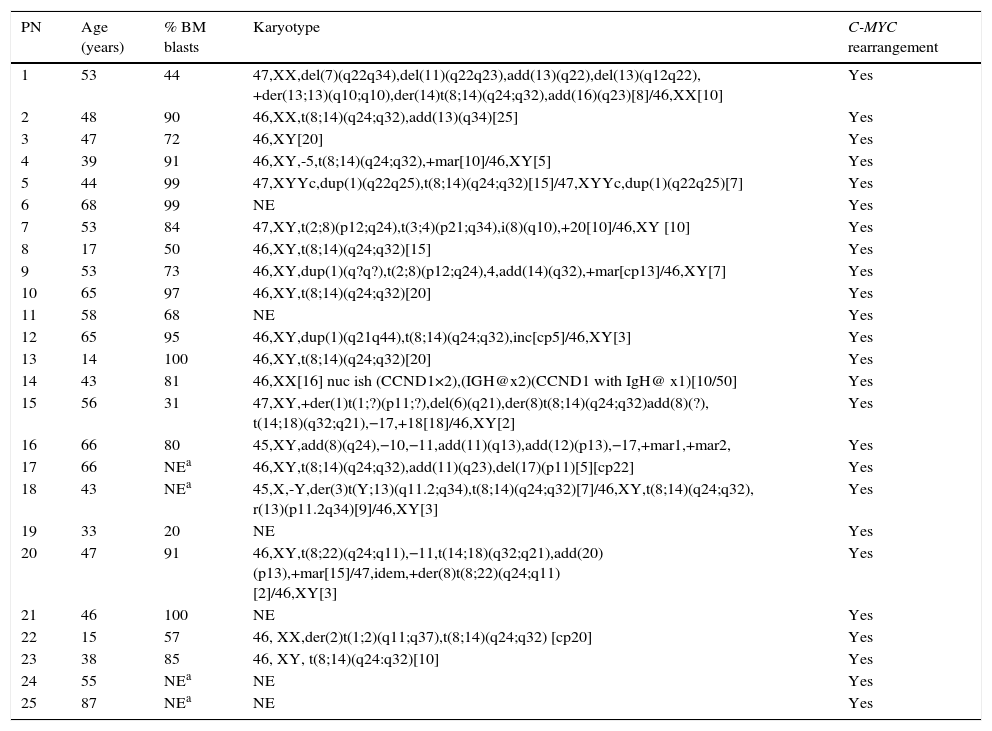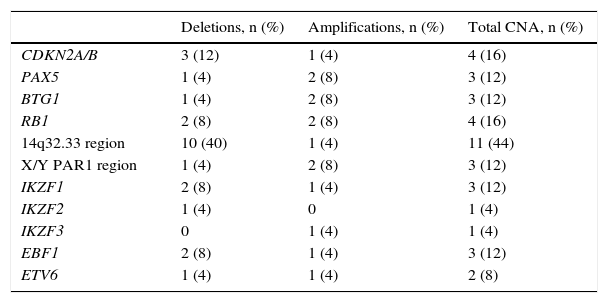Unlike Burkitt lymphoma, molecular abnormalities other than C-MYC rearrangements have scarcely been studied in patients with mature B acute lymphoblastic leukemia (B-ALL). The aim of this study was to analyze the frequency and prognostic significance of copy number alterations (CNA) in genes involved in lymphoid differentiation, cell cycle and tumor suppression in adult patients with B-ALL.
Patients and methodsWe have analyzed by multiplex ligation-dependent probe amplification the genetic material from bone marrow at diagnosis from 25 adult B-ALL patients treated with rituximab and specific chemotherapy.
ResultsThe most frequent CNA were alterations in the 14q32.33 region (11 cases, 44%) followed by alterations in the cell cycle regulator genes CDKN2A/B and RB1 (16%). No correlation between the presence of specific CNA and the clinical-biologic features or the response to therapy was found.
ConclusionsThe high frequency of CNA in the 14q32.33 region, CDKN2A/B and RB1 found in our study could contribute to the aggressiveness and invasiveness of mature B-ALL.
A diferencia del linfoma de Burkitt, las alteraciones moleculares distintas a los reordenamientos de C-MYC apenas se han estudiado en pacientes con leucemia linfoblástica aguda B (LLA-B) madura. El objetivo de este estudio fue analizar la frecuencia y el significado pronóstico de las copy number alterations (CNA, «alteraciones del número de copias») en genes clave de la diferenciación de los linfocitos, ciclo celular y supresores de tumores en pacientes adultos.
Pacientes y métodosSe analizaron, por amplificación de sondas dependiente de ligamento múltiple, muestras de médula ósea en el momento del diagnóstico de 25 adultos con LLA-B madura tratados con rituximab y quimioterapia específica.
ResultadosLas CNA más frecuentes fueron las alteraciones en la región 14q32.33 (11 casos, 44%), seguidas de las alteraciones en los genes reguladores del ciclo celular CDKN2A/B y RB1 (16%). No se encontró correlación entre la presencia de estas CNA y las características clínico-biológicas o de respuesta al tratamiento.
ConclusionesLa alta frecuencia de alteraciones en la región 14q32.33, CDKN2A/B y RB1 encontradas en este estudio podría explicar la agresividad e invasividad de la LLA-B madura.
Artículo
Comprando el artículo el PDF del mismo podrá ser descargado
Precio 19,34 €
Comprar ahora









